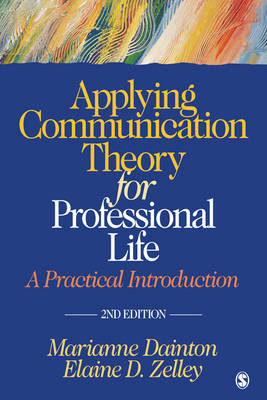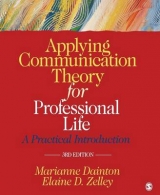
Applying Communication Theory for Professional Life
SAGE Publications Inc (Verlag)
978-1-4129-7691-6 (ISBN)
- Titel erscheint in neuer Auflage
- Artikel merken
Applying Communication Theory for Professional Life: A Practical Introduction, Second Edition is the first communication theory textbook to provide practical material for career-oriented students. The inclusion and analysis of real-world case studies illustrate the application of theory in a variety of professional settings.
Whereas other communication theory texts have a more academic focus on theory or research methods, this book is specifically designed to introduce communication theory in a tangible way. The featured theories are those that have strong pragmatic value and clear applicability to communication and business practitioners. Particular emphasis is placed on theories of intrapersonal communication, interpersonal interaction, intercultural encounters, persuasion, leadership, group communication, organizational behavior, and mass communication.
Marianne Dainton (MA, PhD, The Ohio State University; BA, Villanova University) is a professor of communication at La Salle University in Philadelphia. She teaches communication theory, interpersonal communication, group communication, and organizational communication. Marianne’s research focuses on communication that facilitates relationship maintenance. She has published in Communication Monographs, the Journal of Social and Personal Relationships, Family Relations, and Communication Quarterly, among others. She has also published numerous book chapters and is the co-editor (with Daniel Canary) of Maintaining Relationships Through Communication. Elaine D. Zelley (MA, PhD, The Pennsylvania State University; BA, Ursinus College) is an associate professor of communication at La Salle University in Philadelphia. She teaches communication theory; communication ethics; interpersonal communication; organizational communication; group communication; and sex, gender, and communication. Elaine’s interests focus broadly on women’s roles and relationships including in the workplace and friendships. She was recently a contributing researcher for a collaborative census report on The Gender Gap in Nonprofit Boardrooms. She has also developed pedagogical expertise in curriculum assessment and in understanding by design (UbD). She has published in Communication Yearbook and has also coauthored several book chapters dealing with the topics of relationship maintenance, friendship, and competition.
Preface
Acknowledgments
1. Introduction to Communication Theory
What Is Communication?
What Is Theory?
Evaluating Theory
Chapter Summary
Case Study 1: Evaluating Groupthink
2. Theory Development
The Theory-Research Link
What Is Research?
Research Methods in Communication
Social Science and the Humanities
The Development and Change of Theories
Chapter Summary
Case Study 2: The Development of Attribution Theory
3. Explaining Theories of Cognition and Intrapersonal Communication
The Cognitive Process
Message Design Logics
Communication Accomodation Theory
Uncertainty Reduction Theory
Expectancy Violations Theory
Chapter Summary
Case Study 3: Caught in Between
4. Explaining Theories of Interpersonal Communication
Interpersonal Communication Defined
Politeness Theory
Social Exchange Theory
Dialectical Perspective
Communication Privacy Management Theory
Chapter Summary
Case Study 4: With a Friend Like This . . .
5. Explaining Theories of Group Communication
Group Communication Defined
Systems Perspective
Interaction Process Analysis/SYMLOG
Symbolic Convergence Theory
Functional Group Decision-Making Theory
Chapter Summary
Case Study 5: Dr. Devil and the Doomsday Assignment
6. Explaining Theories of Organizational Communication
Organizational Communication Defined
Organizational Culture
Organizational Assimilation Theory
Organizational Indentification and Control
Organizing Theory
Chapter Summary
Case Study 6: Losing Hope
7. Explaining Theories of Persuasion
Persuasion Defined
Social Judgment Theory
Elaboration Likelihood Model
Theory of Planned Behavior
The Theory of Reasoned Action
Inoculation Theory
Chapter Summary
Case Study 7: The Database Dilemma
8. Explaining Theories of Leadership
Leadership Defined
Likert′s Four Systems
Transformational Leadership
Contingency Model
Leader-Member Exchange
Chapter Summary
Case Study 8: eXtreme Confusion at ECX
9. Explaining Theories of Mediated Communication
Mass Communication Versus Mediated Communication
Media Richness Theory
Uses and Gratifications Theory
Agenda-Setting Theory
Cultivation Theory
Chapter Summary
Case Study 9: Casino Controversy
10. Explaining Theories of Culture
Culture Defined
Hofstede′s Cultural Dimensions
Gender and Communication: A Two-Culture Perspective
Generations and Communication: Workplace Implications
Face Negotiation Theory
11. So What Should a Communicator Do?
Return to Communication Competence
Conclusions About Communication
Conclusions About Influences/Effects
Chapter Summary
Case Study 11: Arguments at Amazing Adventures
References
Index
About the Author
| Erscheint lt. Verlag | 8.6.2010 |
|---|---|
| Verlagsort | Thousand Oaks |
| Sprache | englisch |
| Maße | 152 x 228 mm |
| Gewicht | 340 g |
| Themenwelt | Sozialwissenschaften ► Kommunikation / Medien ► Kommunikationswissenschaft |
| Wirtschaft ► Betriebswirtschaft / Management | |
| ISBN-10 | 1-4129-7691-X / 141297691X |
| ISBN-13 | 978-1-4129-7691-6 / 9781412976916 |
| Zustand | Neuware |
| Haben Sie eine Frage zum Produkt? |
aus dem Bereich



